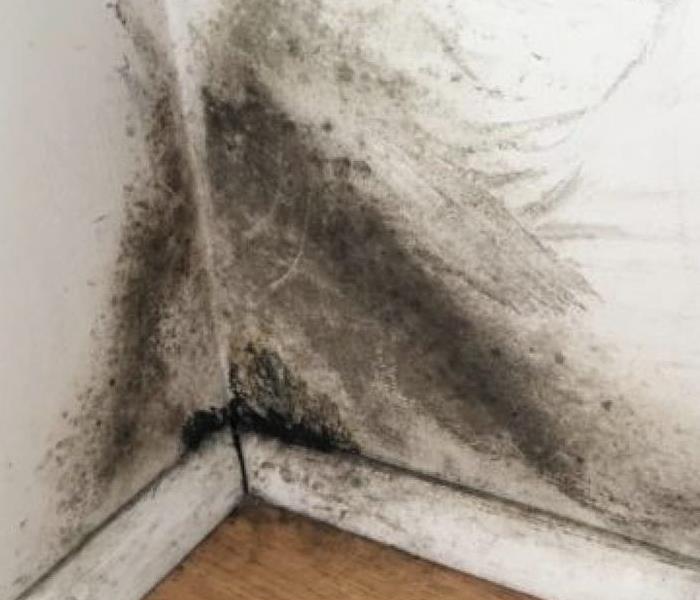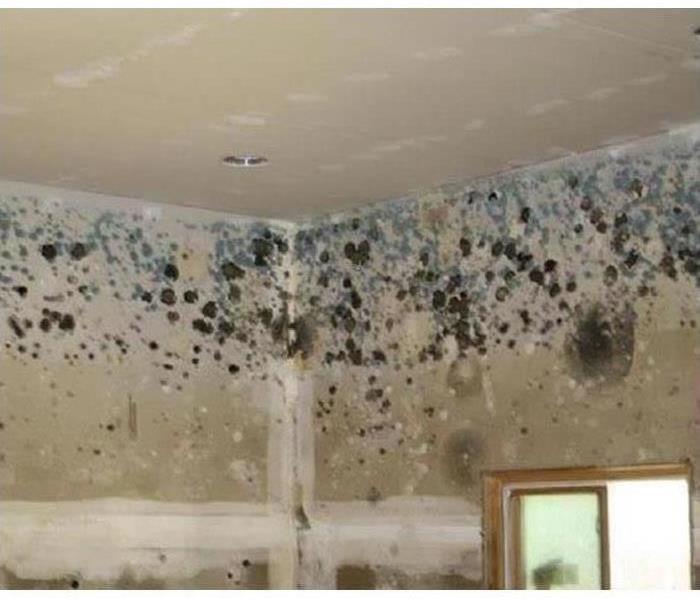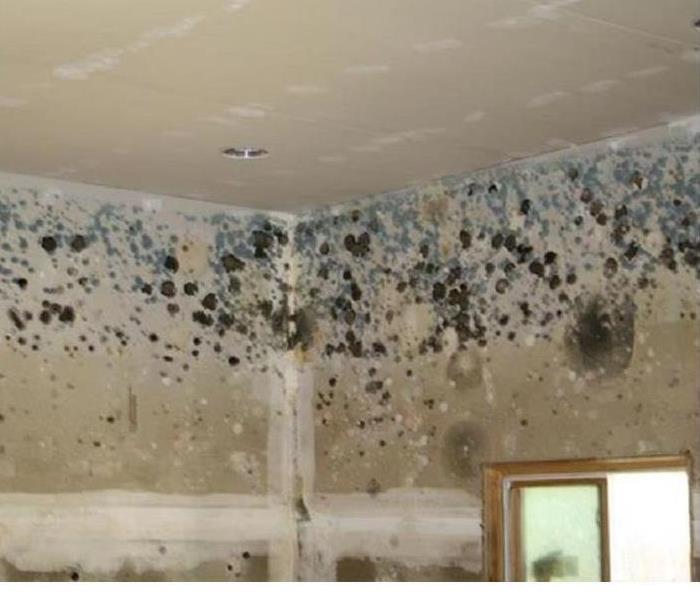Archived Mold Remediation Blog Posts
Did You Find Mold On Popcorn Ceilings?
11/7/2023 (Permalink)
Most mold strains are so minuscule that they can actually be airborne and can settle in all kinds of places. With the right conditions in the presence of moisture, they can germinate easily. Popcorn ceilings are popular due to their distinctive texture that is used to cover up any imperfections in the ceiling. But due to its surface, it is also typically extremely easy to attract mold spores to settle in them and grow into an active colony. Here are some tips for you if you find mold on popcorn ceilings in your home.
How Do I Prevent Mold on My Popcorn Ceiling?
Moisture is a crucial element in the germination of mold. To prevent their growth, you need to keep in mind to ventilate all around your home properly. Some ways can include using the kitchen’s range top vent whenever you are cooking or boiling water, or turning on the bathroom fan for about five to ten minutes after taking a shower. By reducing moisture in the air, it prevents the water vapor from rising and saturating into your popcorn ceiling during evaporation.
Strategic Use of Dehumidifiers
Additionally, underground bedrooms and basements can be vulnerable to the development of bold due to increased moisture, especially during summer when humidity and ambient temperatures are higher. You can counter this by simply placing a dehumidifier in those areas to reduce the level of moisture.
Make Necessary Repairs
Another way moisture can accumulate in your popcorn ceiling is due to a minor roof leak, a clogged gutter, or water leaking into the attic. With time, the accumulated water can saturate your ceiling texture, laying the foundations for increased mold germination.
If there’s damage or an issue, you should almost immediately think about repair solutions before a greater amount of water accumulates and causes a larger mold problem in your home, especially on your popcorn ceiling. Even for plumbing issues, a minor pipe leak in the bathroom upstairs can cause the growth of mold in the ceiling beneath it.
Can I Remove Mold from My Popcorn Ceiling?
If mold does appear on your ceilings, don’t give in to your temptations to paint over them to make them look good. It doesn’t remove the mold; it will also further exacerbate the problem. You can clean it yourself if it’s an early development of mold, by mixing water with a teaspoon of bicarbonate soda. Apply the solution onto the surface and let it sit for a few minutes, before brushing or sponging the affected area. Ventilate the area and let the surface dry thoroughly.
Easy And Fuss-free Clean-up And Restoration Services at SERVPRO of North Prince William County
If you have a more significant mold problem, it’s best to let the professionals do it for you. Here at SERVPRO North Prince William County, our expert, experienced technicians are well-trained and have the required equipment to provide the proper mold remediation and restoration on your popcorn wall. Before help arrives, review these mold damage tips to learn more about what you should and shouldn’t do.
6 Mold Facts
11/3/2022 (Permalink)
We all have heard about mold and how there are over 100,000 different types but here are some interesting things you might have missed.
- Mold has been proven to help gardens grow.
- Mold spreads quickly on walls and other surfaces because it requires growth to survive.
- Bleach does not kill mold it just changes the color of it.
- Mold tends to grow more in dark areas
- Because mold looks a lot like mildew it’s often confused with it.
- Mold can grow in dirty air ducts too, causing mold to circulate around.
To stay safe and healthy from mold check your home regularly. Make sure to check in your basement, ceilings, tiles, under carpets and showers. If mold is found have a professional check it out. SERVPRO of North Prince William County will come and restore your affected property.
Salvaged Items After a Mold Damage
11/17/2021 (Permalink)
Did you know Mold can grow on more than just your walls?
It can grow on a variety of items, from furniture to walls to wood and flooring. When it comes to mold cleaning, however, you may be surprised about the number of objects that can be salvaged when you know the steps for cleaning them properly.
1. Leather Goods
Leather bags, jackets, and other items may be salvageable if you remove them from the affected area quickly. Because mold tends to spread faster in areas with high humidity, you can perform mold remediation for these items by transferring them to a room that is cool and dry. Once the leather has dried, you can sponge the surface with diluted baby soap to wipe away visible mold. Suede goods may need to be treated by a mold cleanup and restoration company.
2. Clothing
While not all clothing can recover from mold damage, you may be able to salvage some items. An Esporta Machine, which is designed to clean cotton clothing affected by mold, smoke, and other substances, can be effective in removing mold. You may be able to soak some fabrics in diluted vinegar to remove the mold, but this depends on how fragile the fabric is. Your restoration experts may able to advise you about other mold cleaning processes.
3. Paintings
Paintings affected by mold require special treatment. You may want to remove any wooden framing, as mold is attracted by wood fibers. Store the painting flat, away from humidity and sunlight, before contacting a professional artwork restoration company. Avoid bagging or sealing it in any kind of tight container, as this may create humid conditions that could encourage further mold growth.
What to do...
When you find mold growth on your belongings, you may not know where to begin with mold cleaning. Contacting SERVPRO of Birmingham for removing your items from areas where mold is present. Our team can help you salvage irreplaceable items and proceed with the rest of the cleanup with confidence.
Drywall Water Damage and Mold Growth
11/30/2020 (Permalink)
 Don't let black mold happen in your home.
Don't let black mold happen in your home.
Floods can cause some lasting damage to your walls as well as ruining your carpets, furniture, and personal belongings. Drywall, which can easily collect and trap moisture inside, if you act quickly enough, you can avoid having to deal with black mold.
Conditions for Mold Growth
Though it may not look that way, mold is alive and it needs food, water, and oxygen to survive. Usually, homes can provide two of these things — oxygen and food. Mold typically feeds on organic matter, such as paper and wood, commonly used for the structural elements of a house. Drywall acts like a sponge so that even 1” of flooding could cause the drywall to become wet up to 4’ from the floor. Also, the paper backing of drywall is a perfect food source full of nutrients for mold.
But of course, when your home is dry, there’s no need to worry. No matter how much organic matter you have in the house, mold won’t start growing without water. But remember — even the smallest excess moisture could spell trouble. That’s why it’s crucial to keep your home dry at all times!
What to Do in Case of Drywall Water Damage
Try as you might to keep your home dry, sometimes things can go wrong. For example, you could experience a flood, or a pipe could suddenly burst in your bathroom, or you could experience a slow leak from your water heater. Either way, you might find yourself having to deal with serious drywall water damage and potential mold growth.
To prevent black mold growth, the first thing you need to do is dry out the area as quickly as possible. If you have any paintings, furniture, or other décor hanging or leaning on the wall, remove them. The damaged area needs to be exposed to air in order to dry faster.
Unfortunately, you need to take down your wallpaper too. That can be time-consuming, but it’s necessary because moisture could accumulate behind it. For that same reason, you should remove all baseboards and molding — they provide perfect hiding places for mold.
Now that your drywall is completely bare, you may begin the drying process. Open the windows to allow air to circulate or get some fans and dehumidifiers to help. Don’t stop until you are 100% certain that the drywall is fully dry. If you’re not sure how to tell, call SERVPRO of North Prince William County today and we can check for you and give you advice.
Once your walls are dry, you can hang your paintings back and re-apply wallpaper. Of course, make sure that no items you put up are wet.
In Conclusion
Black mold on drywall can cause serious damage to your home’s structure, but more importantly your health. If you’ve discovered mold growth despite your best efforts to avoid it, give us a call. Sometimes the problem can be too difficult for you to handle alone but easy enough for a professional mold cleaning company. So don’t hesitate — put your health and the health of your family first and call us today!
What is Black Mold
11/6/2019 (Permalink)
 Black mold on sheetrock
Black mold on sheetrock
Black mold, or stachybotrys chartarum, is a type of living organism that can cause health problems to you and your family. In this article we’re going to take a quick look at how black mold works and what you can do to prevent it from growing in your home.
How Does Black Mold Work?
Black mold grows in an environment that is high in moisture and low in nitrogen, which makes up 78% of the air we breathe. Therefore, we can deduce that if there is not much air movement, but enough water content in a particular environment, mold can grow there. There are plenty of materials in your home that black mold can feed off, drywall, and carpet being among the most common.
How Can We Prevent Mold Growth?
Mold actually grows in abundance in our world, so we cannot get rid of it entirely. However, that doesn’t mean we should accept black mold in our homes. If you have had water damage in your home or business, you should be on the lookout for mold. Preventative measures include making sure that you dry the area thoroughly. Remember to have your carpet properly dried because if the water has been trapped underneath your floor or carpet you will likely have mold growth.
SERVPRO® of North Prince William County is a leader in mold remediation. If you have mold and need help call us today, we’re always here to help! 703-368-4399
Mold Remediation
4/26/2017 (Permalink)
 Mold remediation in Manassas
Mold remediation in Manassas
Mold Removal in Manassas Area
In the Manassas area, mold is a real problem for many families. That’s because it can cause irritation and allergic reactions to people in the household. Mold thrives in humid environment, and as we all know, the summer months are very humid in Northern Virginia.
What is mold?
Mold is a microscopic particle that exist almost everywhere, outdoors and indoors. This makes it impossible to completely remove all mold from a home or business. However, it doesn’t necessarily need to be removed, nor does it become a problem until the humidity – or moisture level – increases. That’s when mold particles begin to grow in number, and form colonies. These colonies are the culprit when it comes to producing allergens and irritants for people, especially to children and people with compromised immune systems.
Another effect of excess mold is the strong odor it produces. It’s an odor that you won’t want to smell again, if you’ve ever smelled it before. If that smell is in your home, where you and your family expect to be comfortable, and to relax, you'll want to get rid of it immediately.
For this reason it is important to monitor the humidity level in your home, especially in Northern Virginia, where the humidity is present year-round, and the summer months can produce conditions in the environment that are favorable for mold growth.
Generally, you want to keep the humidity level below 49%. This is the level at which these mold particles start to thrive and form colonies, producing the odor and causing allergic reactions in many people.
SERVPRO of North Prince William County properly inspects your home for mold, identifies the cause of the odor, and completely removes it without a trace. Give us a call for more information on our mold removal process today!



 24/7 Emergency Service
24/7 Emergency Service


